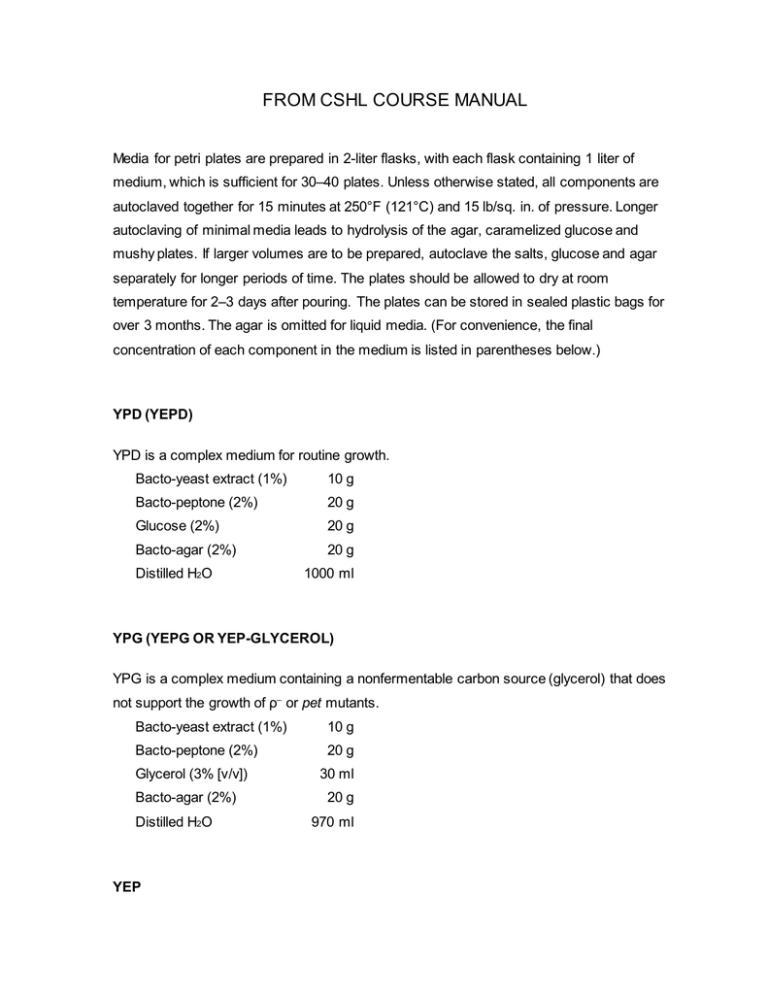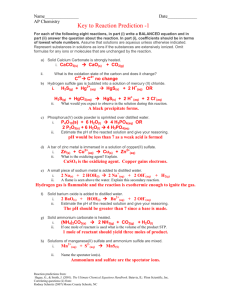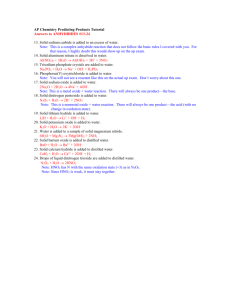FROM CSHL COURSE MANUAL
advertisement

FROM CSHL COURSE MANUAL Media for petri plates are prepared in 2-liter flasks, with each flask containing 1 liter of medium, which is sufficient for 30–40 plates. Unless otherwise stated, all components are autoclaved together for 15 minutes at 250°F (121°C) and 15 lb/sq. in. of pressure. Longer autoclaving of minimal media leads to hydrolysis of the agar, caramelized glucose and mushy plates. If larger volumes are to be prepared, autoclave the salts, glucose and agar separately for longer periods of time. The plates should be allowed to dry at room temperature for 2–3 days after pouring. The plates can be stored in sealed plastic bags for over 3 months. The agar is omitted for liquid media. (For convenience, the final concentration of each component in the medium is listed in parentheses below.) YPD (YEPD) YPD is a complex medium for routine growth. Bacto-yeast extract (1%) 10 g Bacto-peptone (2%) 20 g Glucose (2%) 20 g Bacto-agar (2%) 20 g Distilled H2O 1000 ml YPG (YEPG OR YEP-GLYCEROL) YPG is a complex medium containing a nonfermentable carbon source (glycerol) that does not support the growth of ρ– or pet mutants. Bacto-yeast extract (1%) 10 g Bacto-peptone (2%) 20 g Glycerol (3% [v/v]) Bacto-agar (2%) Distilled H2O YEP 30 ml 20 g 970 ml YEP is a complex medium to which additional carbon sources can be added. For most purposes, a final concentration of 2% sugar is sufficient. If raffinose is used, it is best to prepare a 20% stock solution by filter sterilization through a 0.2 µ Nalgene filter and add 100 ml after the autoclaved media has cooled. Bacto-yeast extract (1%) 10 g Bacto-peptone (2%) 20 g Bacto-agar (2%) 20 g Distilled H2O 900 ml SYNTHETIC DEXTROSE MINIMAL MEDIUM (SD) SD is a synthetic minimal medium containing salts, trace elements, vitamins, a nitrogen source (Bacto-yeast nitrogen base without amino acids), and glucose. Bacto-yeast nitrogen base without amino acids (0.67%) 6.7 g Glucose (2%) 20 g Bacto-agar (2%) 20 g Distilled H2O 1000 ml SYNTHETIC COMPLETE (SC) AND DROPOUT MEDIA SC is SD to which various growth supplements have been added such that nothing required for yeast growth has been omitted, or “dropped out”. The most widely used formulation for SC contains all of the ingredients listed below along with yeast nitrogen base without amino acids and a carbon source, such as glucose. Amino acid mix: Amino acid mix is a combination of the following ingredients. Wherever applicable, HCl salts of amino acids are preferred. Powders should be mixed very thoroughly in a blender. Turning end-over-end for at least 15 minutes also will work; adding a couple of clean marbles helps. Dry growth supplements are stored premixed and are stable for years. L-Adenine 0.5 g L-Leucine 10.0 g L-Alanine 2.0 g L-Lysine 2.0 g L-Arginine 2.0 g L-Methionine 2.0 g L-Asparagine 2.0 g para-Aminobenzoic acid 2.0 g L-Aspartic acid 2.0 g L-Phenylalanine 2.0 g L-Cysteine 2.0 g L-Proline 2.0 g L-Glutamine 2.0 g L-Serine 2.0 g L-Glutamic acid 2.0 g L-Threonine 2.0 g L-Glycine 2.0 g L-Tryptophan 2.0 g L-Histidine 2.0 g L-Tyrosine 2.0 g myo-Inositol 2.0 g Uracil 2.0 g L-Isoleucine 2.0 g L-Valine 2.0 g SC is a medium in which the dropout mix contains all possible supplements (i.e., nothing is “dropped out’’). Bacto-yeast nitrogen base without amino acids (0.67%) 6.7 g Glucose (2%) 20 g Bacto-agar (2%) 20 g Dropout mix (0.2%)* 2g Distilled H2O 1000 ml *Alternatively, SC powder can be purchased from Sunrise Scientific (http://www.sunrisescience.com/pages/ystmedia_sc_sc.html) or Bio101 (http://www.bio101.com/yeast/hopkins.html). In order to test the growth requirements of strains, it is useful to have media in which each of the commonly encountered auxotrophies is supplemented except the one of interest (dropout media). To do this, an ingredient is dropped out of the amino acid mixture. Powders lacking a particular component can be prepared and SC plates lacking that ingredient can be made using the recipe above. If L-Leucine were omitted, these plates would be SC-Leu plates. Other formulations of amino acids are used, including CSM and HC. These typically contain fewer amino acids since most lab strains are only auxotrophic for leucine, adenine, arginine, histidine, tryptophan, uracil, lysine and methionine. Stock solutions of each of the amino acids listed above can be prepared by autoclaving for 15 minutes at 250°F (121°C). These solutions can then be stored for extensive periods. Some should be stored at room temperature in order to prevent precipitation (most typical for adenine, uracil, phenylalanine, glutamic acid, aspartic acid and threonine), whereas the other solutions may be refrigerated. Using these solutions, it is possible to create plates to test for various auxotrophies by spreading a small quantity of the supplement(s) on the surface of an SD plate. The solution(s) should then be allowed to dry thoroughly onto the plate before inoculating it with yeast strains. LIMITING ADE PLATES The ADE2 gene encodes phosphoribosylamino-imidazole-carboxylase, which is essential for the synthesis of adenine. Mutations in ade2 result in the accumulation of the redpigmented 5-phosphoribosyl-5-aminoimidazole. Cells containing a wild-type copy of ADE2 are cream colored, because this compound is quickly metabolized. In addition, mutation in genes that function upstream of Ade2, such as ade3∆, will also be cream colored since synthesis of 5-phosphoribosyl-5-aminoimidazole is blocked at an earlier step. Often, ADE2 or ADE3 are placed on a plasmid or mini-chromosome in a strain containing mutations in ade2 or ade2 ade3, respctively. The rate of plasmid or chromosome loss can be analyzed by studying the formation or red and white sectored colonies. ADE2 can also be a read-out for gene silencing; in an ade2- cell, if the locus containing ADE2 is transcriptionally repressed, the cells will exhibit the ade2- phenotype and appear red, but if repression does not occur and ADE2 is produced, the cells will be Ade+ and appear white. To observe the color changes associated with Ade2, cells are grown on plates containing limiting amounts of adenine. After the colonies appear, a short time in the refrigerator will help the red pigment develop. Bacto-yeast nitrogen base without amino acids (0.67%) 6.7 g Glucose (2%) 20 g Bacto-agar (2%) 20 g -Ade Dropout mix (0.2%)* 2g Distilled H2O 1000 ml *Alternatively, SC powder can be purchased from Sunrise Scientific (http://www.sunrisescience.com/pages/ystmedia_sc_sc.html) or Bio101 (http://www.bio101.com/yeast/hopkins.html). After autoclaving cool media to 55 °C, then add adenine to 10 mg/L. Mix and pour. SPORULATION MEDIUM SPO plates Strains will undergo several divisions on this medium and then sporulate after 3–5 days of incubation. Potassium acetate (1%) Bacto-yeast extract (0.1%) 10 g 1g Glucose (0.05%) 0.5 g Bacto-agar (2%) 20 g CSM powder (0.01%)* 0.1 g Distilled H2O 1000 ml •alternatively, add 0.1 g of amino acid powder Spo media MATa/MATα diploid cells will sporulate on this medium after 18–24 hours without vegetative growth. Potassium acetate (1%) 10 g Bacto-agar (2%) 20 g CSM-Met powder Methionine Distilled H2O 320 mg 20 mg 1000 ml Pre-sporulation media Some cells (BY) require growth in rich YPD (YEP + 4% glucose) for optimal sporulation in Spo media. SK-1 cells are typically grown in YPEG (YEP + 3% glycerol + 2% ethanol) then YPA (YEP + 2% acetate) for optimal sporulation, but will sporulate adequately even if pregrown in YPD. MAL INDICATOR MEDIUM MAL indicator medium is a fermentation-indicator medium used to distinguish strains that ferment or do not ferment maltose. Due to the pH change, the maltose-fermenting strains will change the indicator yellow. Bacto-yeast extract (1%) 10 g Bacto-peptone (2%) 20 g Maltose (2%) 20 g Bromcresol purple solution (0.4% stock solution) 9 ml Bacto-agar (2%) 20 g Distilled H2O 1000 ml 0.4% Bromcresol purple solution: Bromcresol purple 200 mg 100% Ethanol 50 ml X-GAL PLATES FOR LYSED YEAST CELLS ON FILTERS These plates are used for checking β-galactosidase activity in cells that have been lysed and are immobilized on 3MM filters. Bacto-agar 20 g 1 M Na2 HPO4 57.7 ml 1 M NaH2PO4 42.3 ml MgSO4 0.25 g Distilled H2O 900.ml After autoclaving, add 6 ml of X-Gal solution (20 mg/ml in N,N-dimethylformamide). DRUG SELECTION MEDIA 5-Fluoro-orotic Acid Medium 5-Fluoro-orotic acid (5-FOA) can be used to select for mutant cells that fail to utilize orotic acid as the source of the pyrimidine ring. Wild-type cells convert 5-FOA to 5- fluoro-orotidine monophosphate by conjugation to phosphoribosyl pyrophosphate (PRPP), and subsequently decarboxylate it to form 5-fluoro-uridine monophosphate (5-FUMP). These two steps are catalyzed by the products of the yeast genes URA5 and URA3, respectively. Inevitably, fluorodeoxyuridine formed later is a potent inhibitor of thymidylate synthetase and thereby quite toxic to the cell. The two steps of de novo synthesis of uridine that are required to convert 5-FOA to 5-FUMP can be mutated to block utilization, as long as uracil is provided to allow formation of UMP via the salvage pathway. Therefore, both ura3– and ura5– mutants can grow on 5-FOA-containing medium (Boeke et al. 1984). In practice, only ura3– mutants appear to be uracil auxotrophs. The enzyme that catalyzes conjugation of uracil to PRPP can utilize orotic acid as a substrate at some level allowing ura5– mutants to grow slowly in the absence of uracil. Bacto-yeast nitrogen base (0.67%) Drop-out mix – ura (0.2%) Glucose (2%) Uracil (50 6.7 g 2g 20 g g/m l) 5-FOA (0.1%) Distilled H2O 50 mg 1g 500 ml Dissolve the above and filter-sterilize using a 0.2-µm filter. Autoclave the agar separately: Bacto-agar (2%) Distilled H2O 20 g 500 ml Mix the two solutions after cooling the agar to ~80°C. Pour into petri dishes. α-Aminoadipate Plates Wild-type strains are unable to utilize high levels of α-aminoadipate (α-AA) as their sole nitrogen source because it is converted into a toxic intermediate by the normal lysine anabolic pathway (Chattoo et al. 1979; Zaret and Sherman 1985). This medium is frequently used in the selection of mutations in the LYS2 and LYS5 genes. Bacto-yeast nitrogen base without amino acids or ammonium sulfate (0.16%) 1.6 g Glucose (2%) Lysine (30 mg/liter) 20 g 30 mg Bacto-agar (2%) Distilled H2O 20 g 960 ml Autoclave and add 40 ml of a 5% α-AA solution. 5% α-AA: α-Aminoadipic acid Distilled H2O 2g 40 ml Mix and adjust the pH to 6 with 10 N KOH to allow dissolution. Filter-sterilize using a 0.2-µm filter before adding to the autoclaved ingredients. 2-amino-5-fluorobenzoic acid medium 5-fluoroanthranilic acid/2-amino-5-fluorobenzoic acid (5-FBA) can be used for counterselection of TRP1, which encodes phosphribosylanthranilate isomerase that catalyzes the third step in tryptophan biosynthesis. Wild-type cells convert 5-FBA to 5- fluoro-tryptophan, which is toxic to yeast. Because cells that grow on 5-FBA will be tryptophan auxotrophs, tryptophan must be added to the culture media. Selection on 5-FBA was also enhanced by increased glucose and amino acid concentrations (Toyn et al. Yeast 2000). Prepare a 10% stock of 5-FBA in ethanol and filter sterilize. Store in 5 ml aliquots at -20°C. Autoclave the following separately: Bacto-agar (2%) 20 g Gluose (5%) 50 g YNB without amino acids (6.7%) 6.7 g Distilled H2O 900 ml After cooling add the following: 10x supplements stock 10% 5-FBA (0.05%) 100 ml 5 ml Add then pour into petri dishes. 10x supplements stock** A 10x stock of amino acids can be prepared using the powder described above lacking tryptophan, or using SC-TRP or CSM-TRP. Tryptophan should be at a final concentration of 10 ml/L in the media. Cycloheximide Cycloheximide resistance can arise in a number of different genes, but resistance to high levels ordinarily occurs due to rare mutations at the cyh2 locus, which encodes the L29 ribosomal subunit. Resistance to cycloheximide is recessive, presumably because the sensitive ribosomes remain bound to the mRNA and block all further elongation. Cycloheximide can be used in either YPD or synthetic media. A final concentration of 10 mg/liter should be used for YPD and 3 mg/liter for SD, SC, and YPG. A stock solution is prepared by dissolving 100 mg of cycloheximide in 10 ml of distilled H2O and then filtersterilizing (0.2-µm filter). The stock solution can be stored at 4°C. Appropriate volumes can be added to media after autoclaving. Canavanine Canavanine is an analog of arginine. Both are imported into the cell via the same highaffinity permease, which is encoded by the CAN1 locus. High-level resistance to canavanine occurs exclusively because of mutation at this locus, but low-level resistance can arise at a number of other loci. Because canavanine is a competitive inhibitor, arginine must be excluded from media used for testing sensitivity to the drug. Canavanine resistance must also be scored under high-nitrogen conditions, such as those provided by SD or SC medium, since the CAN1 permease will then provide the only entry route to the cell for arginine and canavanine. In the presence of low-nitrogen conditions—effectively those provided by YPD medium—the general amino acid permease (GAP) system is induced and arginine and canavanine can also be taken up by this route. In addition, CanR Arg– auxotrophs are viable on YPD but are inviable on synthetic media because they are unable to take up arginine. Canavanine sulfate is typically made up as a filter-sterilized (0.2-µm filter) 100 mg/ml stock solution in distilled H2O. It is stored at 4°C and added to SD or SC – arg medium after autoclaving. A concentration of 50 mg/liter is typically used for scoring and selecting canavanine resistance. Thialysine Thialysine is an analog of lysine and it is imported into the cell via a permease, which is encoded by the LYP1 locus. Much like canavanine and arginine, lysine and thialysine compete for Lyp1, and LYP1 expression is regulated by the availability of lysine. Therefore, lysine must be removed from the media to score thialysine resistance. Thialysine hydrochloride is typically made up as a filter-sterilized (0.2-µm filter) 100 mg/ml stock solution in distilled H2O. It is stored at 4°C and added to SD or SC – lys medium after autoclaving. A concentration of 50 mg/liter is typically used for scoring and selecting thialysine resistance. G418 The kan gene from the Escherichia coli transposon Tn903 confers resistance to G418. This gene has been engineered into modules used for PCR-based gene disruption and tagging. G418 disulfate salt is made as a filter-sterilized (0.2-µm filter) 200 mg/ml stock solution in distilled H2O. It is stored in aliquots at 4°C. To select for KANMX transformants, YPD is supplemented with 200 mg/L G418. G418 is not effective in minimal media prepared using ammonium sulfate. When using G418, 1 mg/ml monosodium glutamate should be added. SC/MSG + G418: Bacto-YNB without amino acids & without ammonium sulfate (0.67%) 6.7 g Glucose (2%) 20 g Bacto-agar (2%) 20 g Dropout mix (0.2%)* 2g MSG 1g Distilled H2O 1000 ml Autoclave and cool to 55°C. Add 1 ml G418 stock solution then pour. clonNAT The Streptomyces noursei nat1 gene encodes nourseorthricin N-acetyltransferase, which confers resistance to nourseorthricin. This gene has been engineered into modules used for PCR-based gene disruption and tagging. The commercially available version of nourseothricin is clonNAT (Werner Bioagents). It is made as a filter-sterilized (0.2-µm filter) 100 mg/ml stock solution in distilled H2O. It is stored in aliquots at 4°C. To select for NATMX transformants, YPD is supplemented with 100 mg/L clonNAT. It can also be added to SC media without modification. Hygromycin The Klebsiella pneumonia hph gene gene confers resistance to hygromycin B. This gene has been engineered into modules used for PCR-based gene disruption and tagging. Hygromycin B is made as a filter-sterilized (0.2-µm filter) 300 mg/ml stock solution in distilled H2O. It is stored in aliquots at 4°C. To select for NATMX transformants, YPD is supplemented with 300 mg/L Hygromycin B. It can also be added to SC media without modification. Phleomycin The ble gene from the Klebsiella pneumonia Tn5 transposon confers resistance to phleomycin. This gene has been engineered into modules used for PCR-based gene disruption and tagging. To select for BLEMX transformants, YPD is supplemented with 7.5 mg/L Phleomycin. It can also be added to SC media without modification. Bialaphos Bialaphos is a peptide composed of two alanine residues and the glutamine analogue, phosphinothricin, which inhibits glutamine synthase. In order for Bialaphos to be taken up into the cell, the media has to lack peptides and amino acids that would normally compete for Bialaphos for transport. The pat gene from Streptomyces viridochromogenes encodes phosphinothricin N-acetyltransferase, which confers resistance to bialaphos. This gene has been engineered into modules used for PCR-based gene disruption and tagging. To select for PATMX transformants, the following SDP media is used: YNB without amino acids and without ammonium sulfate (1.7%) 1.7 g Proline (1%) 10 g Dextrose (2%) 20 g Bacto-agar (2%) 20 g After autoclaving add bialaphos to 200 mg/L bialaphos (Toku-E). Pour. Note that glufosinate can also be used at 600-800 mg/L.






